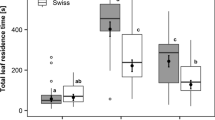Summary
Spiders have been shown to be important predators on ant populations, although ant mortality may be low. Western widow spider (Latrodectus hesperus) predation on Pogonomyrmex rugosus ant nests is slight, less than 0.2% of the nest population per day. Yet, the ants respond by halting foraging temporarily and may even close the nest entrace with pebbles. If spiders are removed from such nests, the ants become active within 24 h and within five days foraging activity reaches higher levels than at any previous time of the year.
Ants have at least four responses to spiders predation: 1) Moving the nest entrace; 2) posting of “guards”; 3) attacking the spiders; 4) halting foraging. Pogonomyrmex rugosus practices the fourth response, although it results in losses of food intake into the nest. This is apparently the only option available. If the ants continue to forage, the spider density may increase, resulting in heavy mortality of the ants.
Similar content being viewed by others
References
Abalos JW (1980) Las arañas del género Latrodectus en la Argentina. Obra del Centenario del Museo de La Plata. 6:29–51
Buren WF (1968) A review of the species of Crematogaster, sensu stricto, in North America (Hymenoptera, Formicidae) Part II, descriptions of new species. J Georgia Entomol Soc 3:91–121
Carico J E (1978) Predatory behavior in Euryopis funebris (Hentz) (Aranea: Theridiidae) and the evolutinoary significance of web reduction. Symp Zool Soc Lond 42:51–58
Clark WH, Comanor PL (1975) Removal of annual plants from the desert ecosystem by western harvester ants, Pogonomyrmex occidentalis. Environ Entomol 4:52–56
Edwards GB, Carroll JF, Whitcomb WH (1974) Stoidis aurata (Araneae: Salticidae), a spider predator of ants. Florida Entomol 57:337–346
Gentry JB (1974) Response to predation by colonies of the Florida harvester ant, Pogonomyrmex badius. Ecology 55:1328–1338
Givens RP (1978) Dimorphic foraging strategies of a salticid spider (Phidippus audax). Ecology 59:309–321
Glatz L (1967) Zur Biologie und Morphologie von Oecobius annulipes Lucas (Araneae, Oecobiidae). Z Morphol der Tiere. 61:185–214
Heller G, (1976) Zum Beutefangverhalten der ameisenfressenden Spinne Callilepis nocturna (Arachnida: Araneae: Drassodidae). Entomol Germanica 3:100–103
Hölldobler B (1970) Steatoda fulva (Theridiidae), a spider that feeds on harvester ants. Psyche 77:202–208
Hölldobler B (1976) The behavioral ecology of mating in harvester ants (Hymenoptera: Formicidae: Pogonomyrmex) Behav Ecol Sociobiol 1:405–423
Kaston BJ (1970) Comparative biology of American black widow spiders. Trans San Diego Soc Nat Hist 16:33–82
Levi HW (1957) The spider genera Crustulina and Steatoda in North America, Central America, and the West Indies (Araneae, Theridiidae). Bull Mus Comp Zool 177:367–424
Levi HW (1977) The orb-weaver genera Metepeira, Kaira and Aculepeira in America north of Mexico (Araneae: Araneidae). Bull Mus Comp Zool 148:185–238
Levieux J (1979) La nutrition des fourmis granivores III. Cycle d'activité et régime alimentaire en saison des pluies de Brachyponera senaarensis (Hym Formicidae Ponerinae) Fluctuations saisonnières. Insect Soc 26:232–239
MacKay WP (1981) A comparison of the ecological energetics of three species of Pogonomyrmex harvester ants (Hymenoptera: Formicidae). Dissertation, University of California at Riverside
McCook HC (1880) The natural history of the agricultural ant of Texas. A monograph of the habits, architecture and structure of Pogonomyrmex barbatus. Lippincott and Co., Philadelphia 311 pp
Menhinick EF (1967) Structure, stability, and energy flow in plants and arthropods in a Serica lespedeza stand. Ecol Monogr 37:255–272
Moggridge JT (1873) Harvesting ants and trapdoor spiders with notes and observations on their habits and dwellings. London xi + 156 pp
Palmgren P (1973) Contributions to the knowledge of the spider fauna of the eastern Alps. Commentat Biol Soc Sci Fenn 71:1–52
Petal J, Breymeyer A (1969) Reduction of wandering spiders by ants in a Stellario-Deschampseitum meadow. Bull Acad Pol Sci Ser Sci Biol 17:239–244
Petal J, Andrzejewska L, Breymeyer A, Olechowicz E (1971) Productivity investigation of two types of meadows in the Vistula Valley: X. The role of ants as predators in a habitat. Ekol Pol 19:213–222
Schneider P (1971) Ameisenjagende Spinnen (Zodariidae) an Cataglyphis-Nestern in Afghanistan. Zool Anz Leipzig 187:199–201
Shepard M, Gibson F (1972) Spider-ant symbiosis: Cotinusa spp. (Araneida: Salticidae) and Tapinoma melanocephalum (Hymenoptera: Formicidae). Canad Entomol 104:1951–1954
Shulov A (1940) On the biology of two Latrodectus spiders in Palestine. Proc Linnean Soc London 152:309–328
Shulov A (1966) Biology and ecology of venomous animals in Isracl. Mem Inst Butantan Simp Internac 33:93–99
Shulov A, Weissman A (1939) Notes on the life habitats and potency of the venom of the three Latrodectus spider species in Israel. Ecology 40:515–518
Van Hook RI (1971) Energy and nutrient dynamics of spider and orthopteran populations in a grassland ecosystem. Ecol Monogr 41:1–26
Weber NA (1957) Fungus-growing ants and their fungi: Cyphomyrmex costatus. Ecology 38:480–494
Author information
Authors and Affiliations
Rights and permissions
About this article
Cite this article
MacKay, W.P. The effect of predation of western widow spiders (Araneae: Theridiidae) on harvester ants (Hymenoptera: Formicidae). Oecologia 53, 406–411 (1982). https://doi.org/10.1007/BF00389022
Received:
Issue Date:
DOI: https://doi.org/10.1007/BF00389022




